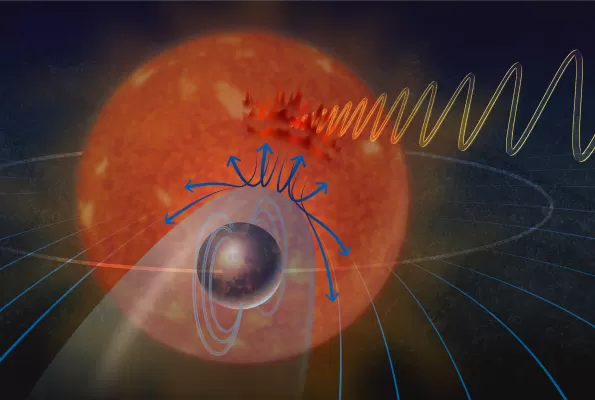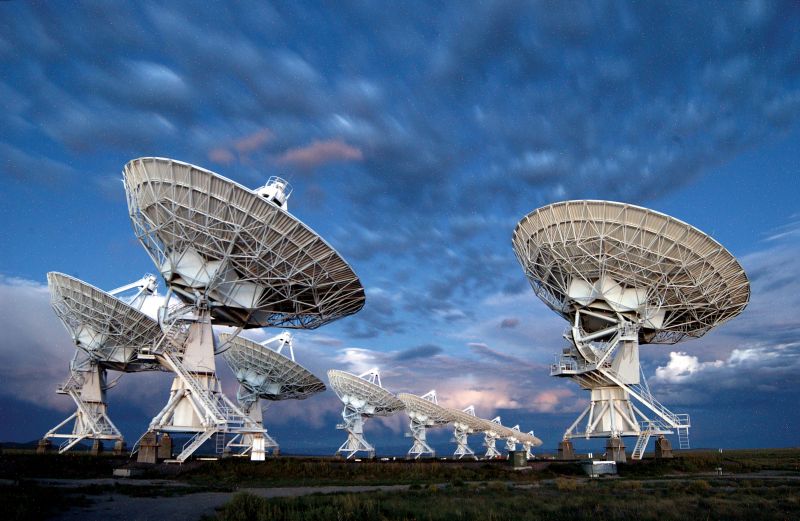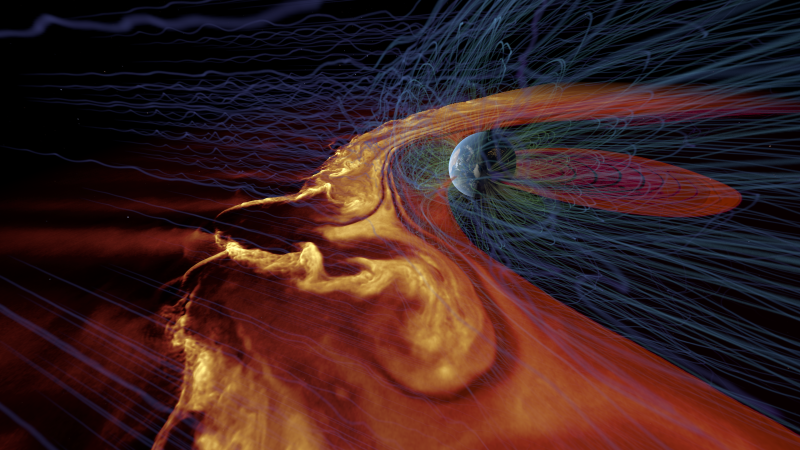
Do Earth-like exoplanets have magnetic fields? Far-off radio signal is promising sign
Radio emissions originating about 12 light-years outside our solar system reveal possible magnetic interactions between star YZ Ceti and its prospective close-orbiting, rocky planet
Earth's magnetic field does more than keep everyone's compass needles pointed in the same direction. It also helps preserve Earth’s sliver of life-sustaining atmosphere by deflecting high energy particles and plasma regularly blasted out of the sun. Researchers have now identified a prospective Earth-sized planet in another solar system as a prime candidate for also having a magnetic field — YZ Ceti b, a rocky planet orbiting a star about 12 light-years away from Earth.
Researchers Sebastian Pineda and Jackie Villadsen observed a repeating radio signal emanating from the star YZ Ceti using the Karl G. Jansky Very Large Array, a radio telescope operated by the U.S. National Science Foundation’s National Radio Astronomy Observatory. Research by Pineda and Villadsen to understand the magnetic field interactions between distant stars and their orbiting planets is supported by NSF. Their research was published today in the journal Nature Astronomy.
"The search for potentially habitable or life-bearing worlds in other solar systems depends in part on being able to determine if rocky, Earth-like exoplanets actually have magnetic fields," says NSF's Joe Pesce, program director for the National Radio Astronomy Observatory. "This research shows not only that this particular rocky exoplanet likely has a magnetic field but provides a promising method to find more."
A planet's magnetic field can prevent that planet's atmosphere from being worn away over time by particles spewed from its star, explains Pineda, an astrophysicist at the University of Colorado. "Whether a planet survives with an atmosphere or not can depend on whether the planet has a strong magnetic field or not."
A radio signal from another star
"I'm seeing this thing that no one has seen happen before," recalls Villadsen, an astronomer at Bucknell University, of the moment she first isolated the radio signal while pouring over data at her home on a weekend.
"We saw the initial burst and it looked beautiful," says Pineda. "When we saw it again, it was very indicative that, OK, maybe we really have something here."
The researchers theorize that the stellar radio waves they detected are generated by the interactions between the magnetic field of the exoplanet and the star it orbits. However, for such radio waves to be detectable over long distances, they must be very strong. While magnetic fields have previously been detected on massive Jupiter-size exoplanets, doing so for a comparatively tiny Earth-sized exoplanet requires a different technique.
"I'm seeing this thing that no one has seen happen before."
- Jackie Villadsen, an astronomer at Bucknell University
Because magnetic fields are invisible, it's challenging to determine if a distant planet actually has one, explains Villadsen. "What we're doing is looking for a way to see them," she says. "We're looking for planets that are really close to their stars and are a similar size to Earth. These planets are way too close to their stars to be somewhere you could live, but because they are so close the planet is kind of plowing through a bunch of stuff coming off the star.
"If the planet has a magnetic field and it plows through enough star stuff, it will cause the star to emit bright radio waves."
The small red dwarf star YZ Ceti and its known exoplanet, YZ Ceti b, provided an ideal pair because the exoplanet is so close to the star that it completes a full orbit in only two days. (By comparison, the shortest planetary orbit in our solar system is Mercury's at 88 days.) As plasma from YZ Ceti careens off the planet's magnetic "plow," it then interacts with the magnetic field of the star itself, which generates radio waves strong enough to be observed on Earth.
The strength of those radio waves can then be measured, allowing researchers to determine how strong the magnetic field of the planet might be.
Northern lights on another world?
"This is telling us new information about the environment around stars," says Pineda. "This idea is what we're calling 'extrasolar space weather.'"
The sun's high energy particles and sometimes huge bursts of plasma create solar weather closer to home, around Earth. Those ejections from the sun can disrupt global telecommunications and short-circuit electronics in satellites and even on Earth's surface. The interaction between solar weather and Earth's magnetic field and atmosphere also creates the phenomenon of the aurora borealis, or northern lights.
The interactions between YZ Ceti b and its star also produce an aurora, but with a significant difference: The aurora is on the star itself.
"We're actually seeing the aurora on the star — that's what this radio emission is," explains Pineda. "There should also be aurora on the planet if it has its own atmosphere."
Both researchers agree that while YZ Ceti b is the best candidate yet for a rocky exoplanet with a magnetic field, it's not a closed case. "This could really plausibly be it," says Villadsen. "But I think it's going to be a lot of follow-up work before a really strong confirmation of radio waves caused by a planet comes out."
"There are a lot of new radio facilities coming online and planned for the future," says Pineda of the possibilities for future research. "Once we show that this is really happening, we'll be able to do it more systematically. We're at the beginning of it."





